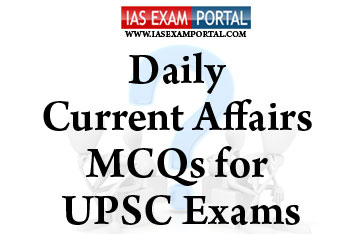
Current Affairs MCQ for UPSC Exams - 02 September 2019
Q1. Consider the following statements regarding occurrence of forest fires :
1) Human activities near or within forested areas are the number one cause of
forest fires.
2) Lightning is the biggest natural cause of forest fires.
3) Sometime volcanic activities such as eruptions and lava flow can cause forest
fires.
4) Human-caused fires constitute the greater percentage of forest fires in our
forests, but natural fires constitute the great majority of the total area
burned.
Which of the above statements are true ?
a) 1 & 2 only
b) 2 & 3 only
c) 1 & 3 only
d) all of the above
Q2. Consider the following hill stations of India with their location states
:
1) Panchgani : Madhya Pradesh
2) Chail : Himachal pradesh
3) Horsley hills : Maharashtra
4) Patnitop : Jammu & Kashmir
5) Almora :Uttarakhand
Which of the above pairs are incorrectlymatched ?
a) 1,2& 3 only
b) 3 & 5 only
c) 1 & 3 only
d) 2 & 4 only
Q3. Recently beaches in Chennai witnessed a blue shimmer on the waves. The
visitors spotted a magical blue glow on the beach. Which of the following
statements regarding the same stands true ?
1) According to marine experts, the blue glow is known as Bioluminescence.
The phenomenon is caused by Noctilucascintillans, a type of phytoplankton that
converts their chemical energy into light energy when washed ashore.
2) Similar to the sight of fireflies, bioluminescence is found in many marine
organisms such as bacteria, algae, jellyfish, worms, crustaceans, sea stars,
fish and sharks.
3) The occurrence of these phytoplanktons is highly beneficial to the ecosystem
in the long run as they provide food for the fishes.
a) 1 & 2 only
b) 2 & 3 only
c) 1 & 3 only
d) all of the above
Q4. Consider the following statements :
1) The RBI earns money in a variety of ways like the Open market operations,
wherein a central bank purchases or sells bonds in the open market in order to
regulate money supply in the economy, are a major source of income for the RBI.
2) Dealings in the foreign exchange market that the RBI engages in may also
contribute to the bank’s profits.
3) However, that unlike commercial banks, the primary mandate of the RBI is not
to earn profits but to preserve the value of the rupee. Profit and loss are thus
merely a side effect of its regular operations to shape monetary policy.
Which of the above statements stands true ?
a) 1 & 2 only
b) 2 & 3 only
c) 1 & 3 only
d) all of the above
Q5. Which of the following cities have been ranked number one in the safe
city index (SCI-2019) by the economic intelligence unit ?
a) London
b) Tokyo
c) Beijing
d) Ottawa


